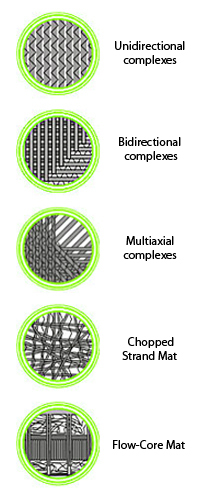 Often known as Non-Crimp Fabrics. Made up of one, two or multiple plies of unbent (non-crimp) fibres, each laying in a different orientation or axis. These layers are typically stitch bonded to form a fabric of different form like a unidirectional fabric, bidirectional fabric or multiaxial fabrics.
Often known as Non-Crimp Fabrics. Made up of one, two or multiple plies of unbent (non-crimp) fibres, each laying in a different orientation or axis. These layers are typically stitch bonded to form a fabric of different form like a unidirectional fabric, bidirectional fabric or multiaxial fabrics.
Few inherent advantages over traditional forms of reinforcements are:
- The reinforcing fibres can be placed in different axis to optimise the performance of the finished laminate.
- No resin-rich areas mean that it is easy to achieve a higher fibre volume fraction (fvf).
- Non-crimped (unbent) fibres mean higher tensile and flexural properties in the finished laminate.
- Fabrics are easier to handle as the stitching holds the material together.
- Greater flexibility to select resin systems.
Unidirectional complexes in both 0° and in 90° direction. This stitch bonded material is produced with reinforcing threads, with or without a csm or fleece.
Bidirectional complexes in 0°/90° direction. As an option, a csm or fleece can be stitched onto the upper or lower side.
Multiaxial complexes with various weights, variable directions and arrangement of the individual layers. Angles between 22.5° and 90° possible. Some options of Bidiagonal, Triaxial and Quadraxial are –(45°/+45°) or (0°/-45°/+45°) or (-45°/90°/+45°) or (0°/45°/90°/+45°).
Chopped Strand Mat (CSM) made of cut glass fibres, without binder and chemicals with random fibre orientation. Stitch bonding gives these fabrics an excellent wetability and holding strength.
Flow-Core Mat is stitched bonded, glued or needled sandwich complexes with any desired core materials, e.g. polypropylene as resin flow zone. Desired amount of chopped glass or any stitch bonded fabric is on both or one side of resin flow core.